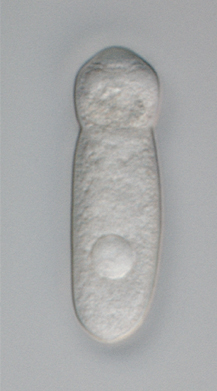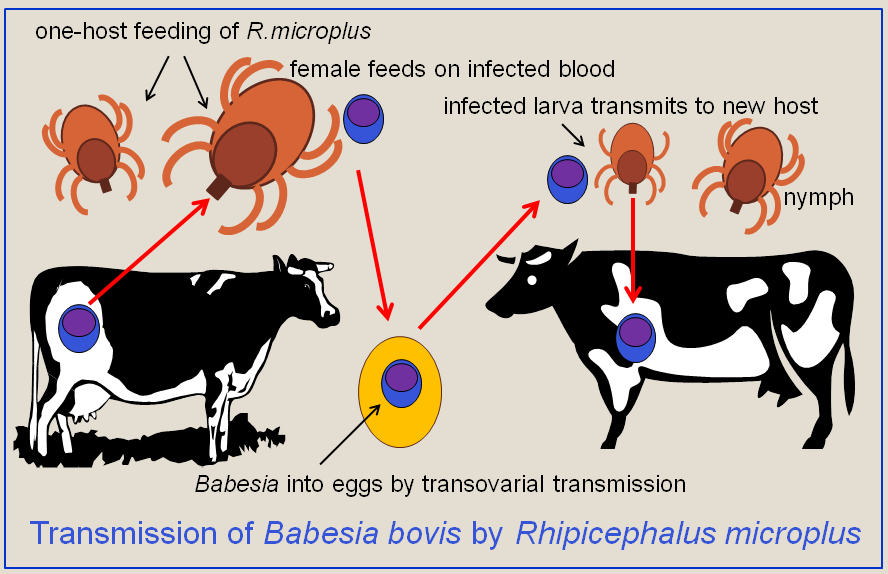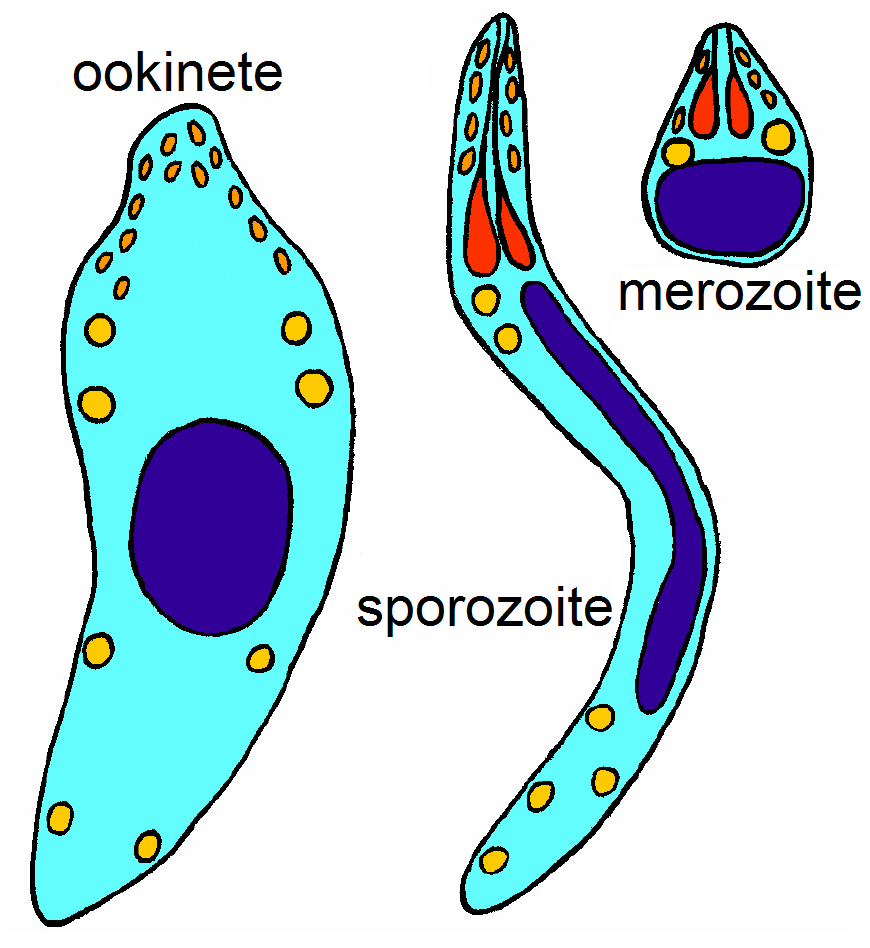|
Piroplasm
Piroplasmida is an order of parasites in the phylum Apicomplexa. They divide by binary fission and as sporozoan parasites they possess sexual and asexual phases (sexual reproduction occurs in the tick gut). They include the tick parasites '' Babesia'' and ''Theileria''. Description They are minute rounded or pyriform parasites found within erythrocytes, or other circulating or endothelial cells of vertebrates, where they reproduce by merogony. The trophozoite stage is separated from erythrocyte by a single membrane. This distinguishes them from other blood parasites that usually have at least two membranes. An apical complex with a polar ring and rhopteries occurs, but without a conoid and usually without associated pellicular microtubules. They lack flagella and do not form either oocysts or spores. The known vectors are ticks or leeches in which they undergo sporogony; sexual reproduction probably occurs in the vector. See also * Babesiosis Babesiosis or piro ... [...More Info...] [...Related Items...] OR: [Wikipedia] [Google] [Baidu] |
Apical Complex
The Apicomplexa (also called Apicomplexia) are a large phylum of parasitic alveolates. Most of them possess a unique form of organelle that comprises a type of non-photosynthetic plastid called an apicoplast, and an apical complex structure. The organelle is an adaptation that the apicomplexan applies in penetration of a host cell. The Apicomplexa are unicellular and spore-forming. All species are obligate endoparasites of animals, except ''Nephromyces'', a symbiont in marine animals, originally classified as a chytrid fungus. Motile structures such as flagella or pseudopods are present only in certain gamete stages. The Apicomplexa are a diverse group that includes organisms such as the coccidia, gregarines, piroplasms, haemogregarines, and Plasmodiidae, plasmodia. Diseases caused by Apicomplexa include: * Babesiosis (''Babesia'') * Malaria (''Plasmodium'') * Cryptosporidiosis (''Cryptosporidium parvum'') * Cyclosporiasis (''Cyclospora cayetanensis'') * Cystoisosporiasis (''Cys ... [...More Info...] [...Related Items...] OR: [Wikipedia] [Google] [Baidu] |
Apicomplexa
The Apicomplexa (also called Apicomplexia) are a large phylum of parasitic alveolates. Most of them possess a unique form of organelle that comprises a type of non-photosynthetic plastid called an apicoplast, and an apical complex structure. The organelle is an adaptation that the apicomplexan applies in penetration of a host cell. The Apicomplexa are unicellular and spore-forming. All species are obligate endoparasites of animals, except '' Nephromyces'', a symbiont in marine animals, originally classified as a chytrid fungus. Motile structures such as flagella or pseudopods are present only in certain gamete stages. The Apicomplexa are a diverse group that includes organisms such as the coccidia, gregarines, piroplasms, haemogregarines, and plasmodia. Diseases caused by Apicomplexa include: * Babesiosis ('' Babesia'') * Malaria (''Plasmodium'') * Cryptosporidiosis ('' Cryptosporidium parvum'') * Cyclosporiasis ('' Cyclospora cayetanensis'') * Cystoisosporiasis ('' Cys ... [...More Info...] [...Related Items...] OR: [Wikipedia] [Google] [Baidu] |
Babesiosis
Babesiosis or piroplasmosis is a malaria-like parasitic disease caused by infection with a eukaryotic parasite in the order Piroplasmida, typically a '' Babesia'' or ''Theileria'', in the phylum Apicomplexa. Human babesiosis transmission via tick bite is most common in the Northeastern and Midwestern United States and parts of Europe, and sporadic throughout the rest of the world. It occurs in warm weather. People can get infected with ''Babesia'' parasites by the bite of an infected tick, by getting a blood transfusion from an infected donor of blood products, or by congenital transmission (an infected mother to her baby). Ticks transmit the human strain of babesiosis, so it often presents with other tick-borne illnesses such as Lyme disease. After trypanosomes, ''Babesia'' is thought to be the second-most common blood parasite of mammals. They can have major adverse effects on the health of domestic animals in areas without severe winters. In cattle the disease is known ... [...More Info...] [...Related Items...] OR: [Wikipedia] [Google] [Baidu] |
Theileria
''Theileria'' is a genus of parasites that belongs to the phylum Apicomplexa, and is closely related to '' Plasmodium''. Two ''Theileria'' species, ''T. annulata'' and ''T. parva'', are important cattle parasites. ''T. annulata'' causes tropical theileriosis and ''T. parva'' causes East Coast fever. ''Theileria'' species are transmitted by ticks. The genomes of ''T. orientalis'' Shintoku'', Theileria equi'' WA, ''Theileria annulata'' Ankara and ''Theileria parva'' Muguga have been sequenced and published. ''Theileria equi'' is a known cause of equine piroplasmosis. Vaccines against ''Theileria'' are in development. In May 2010, a vaccine that was reported to protect cattle against East Coast fever had been approved and registered by the governments of Kenya, Malawi, and Tanzania. Description Species in this genus undergo exoerythrocytic merogony in the lymphocytes, histiocytes, erythroblasts, and other cells of the internal organs. This is followed by invasion of the ery ... [...More Info...] [...Related Items...] OR: [Wikipedia] [Google] [Baidu] |
Babesia
''Babesia'', also called ''Nuttallia'', is an apicomplexan parasite that infects red blood cells and is transmitted by ticks. Originally discovered by the Romanian bacteriologist Victor Babeș in 1888, over 100 species of ''Babesia'' have since been identified. ''Babesia'' comprises more than 100 species of tick-borne parasites that infect erythrocytes (red blood cells) in many vertebrate hosts. ''Babesia'' species infect livestock worldwide, wild and domestic vertebrate animals, and occasionally humans, where they cause the disease babesiosis. In the United States, ''B. microti'' is the most common strain of the few which have been documented to cause disease in humans. Classification ''Babesia'' is a protozoan parasite found to infect vertebrate animals, mostly livestock mammals and birds, but also occasionally humans. Common names of the disease that ''Babesia microti'' causes are Texas cattle fever, redwater fever, tick fever, and Nantucket fever. The disease it cause ... [...More Info...] [...Related Items...] OR: [Wikipedia] [Google] [Baidu] |
Babesia Microti
Babesia microti is a parasitic blood-borne piroplasm transmitted by deer ticks. ''B. microti'' is responsible for the disease babesiosis, a malaria-like disease which also causes fever and hemolysis. Life cycle The life cycle of ''B. microti'' includes human red blood cells and is an important transfusion-transmitted infectious organism. Between 2010 and 2014 it caused four out of fifteen (27%) fatalities associated with transfusion-transmitted microbial infections reported to the US FDA (the highest of any single organism). In 2018, the FDA approved an antibody-based screening test for blood and organ donors. An important difference from malaria is that ''B. microti'' does not infect liver cells. Additionally, the piroplasm is spread by tick bites (''Ixodes scapularis'', the same tick that spreads Lyme disease), while the malaria protozoans are spread via mosquito. Finally, under the microscope, the merozoite form of the ''B. microti'' lifecycle in red blood cells forms a ... [...More Info...] [...Related Items...] OR: [Wikipedia] [Google] [Baidu] |
Echinozoon
''Echinozoon'' is a genus of parasitic alveolates of the phylum Apicomplexia. There is one species in this genus - ''Echinozoon hoogstraali''. History The species and genus was described in 1951 by Garnham. The parasite was isolated from a bush rock hyrax ('' Heterohyrax brucei hoogstraali'') in 1950 by Hoogstraal and Lawless in Torit, South Sudan. Description Filaments are present on parasitized erythrocytes making their identification easy. The earliest stages (ring forms) are less than two micrometers in size and are oval or round in shape. No filaments are evident at this stage unlike all later stages. The parasites occur singly in the erythrocytes. A vacuole is present. The nucleus is irregular. Later stages occur in two forms. The smaller of these may be up to 5 micrometers in size, circular in outline, with pale blue cytoplasm that is free of granules. The nucleus lies to the side of the vacuole. The larger form may be up to nine micrometers in size. The cytoplasm is ... [...More Info...] [...Related Items...] OR: [Wikipedia] [Google] [Baidu] |
Entopolypoides
''Entopolypoides'' is a genus of parasites belonging to the phylum Apicomplexa. History The type species (''Entopolypoides macaci'') was described by Mayer in 1934 in a '' Macaca irus'' monkey from Java. Description Young parasites are delicate rings with a large vacuole but the more mature parasites have several fine long processes. After three days in the erythrocyte the parasite divides into four. There is no synchronicity of division. Host range * vervet monkeys ('' Cercopithecus aethiops pygerythrus'') * Syke's monkeys (''Cercopithecus mitis'') * long tailed macaques (''Macaca fascicularis'') * macaque ('' Macaca irus'') * yellow baboon ('' Papio cynocephalus'') Note The genus ''Entopolypoides'' may be synonymous with that of ''Babesia ''Babesia'', also called ''Nuttallia'', is an apicomplexan parasite that infects red blood cells and is transmitted by ticks. Originally discovered by the Romanian bacteriologist Victor Babeș in 1888, over 100 species of ''Babesia'' h ... [...More Info...] [...Related Items...] OR: [Wikipedia] [Google] [Baidu] |
Haemohormidium
''Haemohormidium'' is a genus of parasitic alveolates in the phylum Apicomplexia. They have two hosts in their life cycle: the vertebrate hosts are fish and the invertebrate vectors are leeches. Taxonomy The genus was created in 1910 by Henry who described the type species, ''Haemohormidium cotti'', in the short spined sea scorpion ('' Myxocephalus scorpius'') and the long spined sea scorpion (''Taurulus bubalis''). Its nature was unclear until the electron microscopic studies revealed its relationship to the Apicomplexia. Henry in 1913 abandoned the name but the genus was validated by Wenyon in 1926. The species in the genus '' Babesiosoma'' were initially incorporated into this genus in 1969 but have subsequently been demerged. Some authors consider this genus to be synonymous with ''Dactylosoma''. Henry also in 1910 described a second genus - ''Haematractidium'': this is now considered synonymous with ''Haemohormidium''. It seems that the taxonomy of this group may yet un ... [...More Info...] [...Related Items...] OR: [Wikipedia] [Google] [Baidu] |
Tick
Ticks (order Ixodida) are parasitic arachnids that are part of the mite superorder Parasitiformes. Adult ticks are approximately 3 to 5 mm in length depending on age, sex, species, and "fullness". Ticks are external parasites, living by feeding on the blood of mammals, birds, and sometimes reptiles and amphibians. The timing of the origin of ticks is uncertain, though the oldest known tick fossils are from the Cretaceous period, around 100 million years old. Ticks are widely distributed around the world, especially in warm, humid climates. Ticks belong to two major families, the Ixodidae or hard ticks, and the Argasidae, or soft ticks. '' Nuttalliella,'' a genus of tick from southern Africa is the only member of the family Nuttalliellidae, and represents the most primitive living lineage of ticks. Adults have ovoid/pear-shaped bodies (idiosomas) which become engorged with blood when they feed, and eight legs. Their cephalothorax and abdomen are completely fused. In ad ... [...More Info...] [...Related Items...] OR: [Wikipedia] [Google] [Baidu] |
Sporogony
Apicomplexans, a group of intracellular parasites, have Biological life cycle, life cycle stages that allow them to survive the wide variety of environments they are exposed to during their complex life cycle. Each stage in the life cycle of an apicomplexan organism is typified by a ''cellular variety'' with a distinct morphology (biology), morphology and biochemistry. Not all apicomplexa develop all the following cellular varieties and division methods. This presentation is intended as an outline of a hypothetical generalised apicomplexan organism. Methods of asexual replication Apicomplexans (sporozoans) replicate via ways of multiple fission (also known as schizogony). These ways include , and , although the latter is sometimes referred to as schizogony, despite its general meaning. Merogony is an asexual reproduction, asexually reproductive process of apicomplexa. After infecting a host cell, a trophozoite (#Glossary, see glossary below) increases in size while repeatedly ... [...More Info...] [...Related Items...] OR: [Wikipedia] [Google] [Baidu] |



